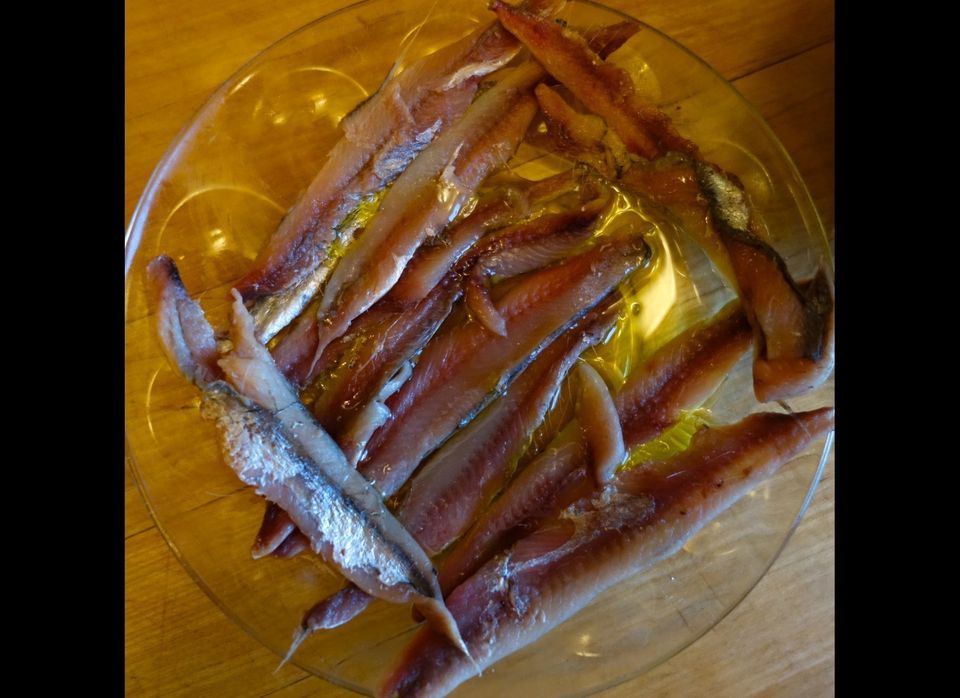In the winter, sometimes it's nice to eat a seasonless dinner, one that doesn't depend on a chilly trip to the farmers market; pasta often fills that bill. For quite some time now, my go-to no-marketing red-sauce dish has been bucatini or other pasta all'Amatriciana, but a couple of days ago I found that I was running low on guanciale, a key ingredient in its wonderful sauce. What I was far from running low on was anchovies, of which I acquired at least a year's supply right after a recent trip to Rome and Venice, where they seemingly turned up in everything we ate apart from the doughnuts.
Indeed, I had a supply of most of the savory and/or salty pantry items that have saved the day for countless cooks: capers, olives, good-quality canned tomatoes -- and of course that stockpile of anchovies. Along with olive oil, garlic and dried chilis, these added up to the sauce for pasta alla puttanesca (there is lots of tedious speculation about the origin of that name, and you can pass the time running internet searches for it unless you'd rather be doing something gratifying). What with our long-running Amatriciana phase and our fondness for Venetian onion-anchovy salsa, Jackie and I hadn't had that great Neapolitan classic for quite some time.
So, the other night we did. It's one of those recipes that lodge in the memory, and what I describe is pretty much the classic dish, distorted by just one personal preference that I think enhances it without betraying it.
I begin with my innovation: Typically, the sauce is made with plain peeled tomatoes, fresh or (more often) canned, and there's no reason not to make it that way. But, as with my Amatriciana sauce, I prefer to tinker with the tomatoes first: I cook a can of genuine San Marzano tomatoes, crushed in my fist, for 20 minutes with a whole garlic clove, quite a bit of olive oil, a few sage leaves and a wee bit of salt: the simplest of simple tomato sauces and the one I like to keep in the house (especially when made with fresh late-summer tomatoes instead of canned, but that's an idle dream in December). As that was simmering, I prepared the other ingredients.
For two or three portions, I rinsed five salt-packed anchovies and soaked them for five minutes in tepid water, then used my fingers to open them lengthwise, remove the backbones and any traces of innards and separate them into two fillets each. These I rinsed again, dried on a paper towel and set aside, drizzled with a little olive oil. If I hadn't had my monster can of salt-cured anchovies, I would have used ten oil-packed anchovy fillets, which are more likely to be in most cupboards or fridges. I also rinsed, dried and roughly chopped a good quarter cup of capers (about 65 ml by volume - a little handful); again, I used salt-packed capers, but those in vinegar work fine. I roughly chopped 2/3 cup (160 ml by volume) of olives that had been pitted. I used a mixture of meaty, flavorful green and black olives; you could use all black ones such as Gaeta or Kalamata, but I like the diversity of juiciness that you get with an assortment. Finally, I chopped three cloves of garlic, not too fine.
I began by cooking the garlic in a deep skillet with about three tablespoons of good olive oil. When the garlic began to turn toasty golden, I added a sprinkle of Calabrian chili flakes, then a few seconds later the anchovies, which I stirred and pressed with a spatula until they seemed to dissolve into the oil -- a matter of moments. Then, in went the capers and olives and half a minute later about 2/3 of the sauce (which had been made with one 28-ounce -- 800-gram -- can of tomatoes). I brought this to the boil and left it to simmer, loosely covered, for perhaps fifteen minutes, tasting for salt.
Meanwhile, I brought a pot of salted water to the boil, and when the sauce was done cooked two portions of spaghettini (not my first choice: I was out of thicker spaghetti). As it cooked, I chopped a handful of parsley and kept it at the ready. When the pasta was done, I drained it (saving a cup - 250 ml - of the cooking water) and added it to the sauce, combining everything thoroughly with a pair of tongs. Once the pasta had absorbed some of the liquid, the sauce needed nearly half of the reserved water to be a nice consistency -- thick enough to cling to the spaghettini, but not cludgy. I turned it out into a serving bowl and incorporated some of the parsley, then added more as a topping. The parsley is not optional: you'll be surprised how much flavor it adds. No cheese, please; there's plenty of umami as it is.
You can tell from the ingredients that this is not a shy kind of sauce. Yet neither is it particularly aggressive; all those powerful elements are cooked long enough with the tomatoes that they combine to create a united savoriness. But they don't entirely lose their individuality: To play a little game, concentrate on a forkful and you'll be able to taste every single thing that's in your mouth.
All that flavor without having had to bundle up and go out into the frigid weather!
